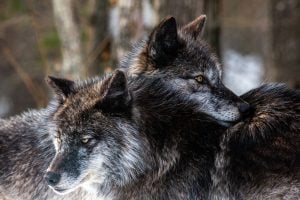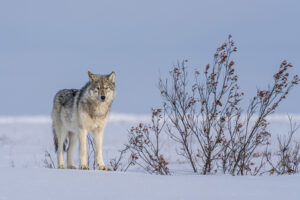
Wildlife
The big bad wolf?
Exploring our love-hate relationship with the wolf
- 2255 words
- 10 minutes
This article is over 5 years old and may contain outdated information.
Travel
Thompson, Manitoba is trying to gain some international wildlife recognition

It all began with a 10-storey reproduction of wildlife painter Robert Bateman’s Wolf Sketch. Completed in 2005, it was to be just one of many sights on Spirit Way, the two-kilometre walking and biking route in Thompson, Man., that lassos 16 of the city’s attractions.
“But when the mural was finished, it was like the floodgates had opened,” says Volker Beckmann, Spirit Way project co-ordinator, referring to the onslaught of wolf-related media, researcher and wildlife-enthusiast attention that ensued. “If it had been anything else we probably wouldn’t now be hosting wildlife conferences [the first International Wolf and Carnivore Conference was held in Thompson in 2012] and drawing wolf researchers from all over the world.”
Canada is home to an estimated 50,000 grey wolves, the world’s largest population, and a full 10 per cent of those are thought to hunt in Manitoba. Yet it could just as easily have been a lynx, bald eagle or moose mural on that Thompson building — all are common to the region, and were considered as options for the largest lighted mural in the world. No other animal, however, could have tapped the city into anything close to the stream of international fervor, curiosity and controversy that wolves generate. Throughout history and around the globe, these polarizing creatures have been feared, hated and exterminated or loved and protected. Thompson locals, used to living in a place bounded by the dark, dense boreal forest that wolves love, are quite tolerant of the carnivores (which are actually rarely seen). The area’s aboriginal groups have sustainably harvested wolves along with other species, such as the beaver, for many hundreds of years, and continue to pass down their traditional knowledge of the animals and trapping practices.
A number of two-metre-plus wolf statues, variously sponsored and wildly painted (now numbering more than 50, with 35 in Thompson and the rest in Winnipeg and Churchill, also forming a province-wide GPS Wolf Hunt game), were a colourful next step, and built on a theme that was quickly getting too big for its Spirit Way origins.
In 2009, Thompson’s (now former) mayor declared the city the “Wolf Capital of Canada.” Never complacent, Beckmann and the rest of the Spirit Way volunteer team are now looking at how the city could be formally recognized as the Wolf Capital of the World — a few years down the road, perhaps. The worldwide designation is still unofficial, but researchers from major wolf organizations (such as the International Wolf Centre in Minneapolis) and many other outsiders are already supporting Thompson’s bid.
Meanwhile, no other community has made or disputed the claim, and the small Manitoba city of about 13,000, which operates as a regional service centre for around 70,000 northern Manitobans, is fast developing the infrastructure — for wolf tourism, research, education, special events and arts and culture — necessary to live up to the title. “The wolves here have never been studied,” says Beckmann. “We don’t have the roads, pipelines or logging areas that they have in Alberta and B.C., and there are no farmers or ranchers up here. We have all the raw resources to do this and none of the conflict issues.”
Much is in the works — 13 or 14 different projects, to be more specific — fruits of the more than $1.9 million raised by the non-profit group to date. The outside work on a captive wolf exhibit is done, with an accompanying viewing and study centre now taking shape. They’re just waiting for a new litter of wolf pups from Ontario’s Haliburton Forest Wolf Centre. Locals and visitors have been recording their wild wolf sightings, along with images and sighting data, on the Spirit Way website, and ongoing and potential scientific studies, as well as opportunities for partnerships with universities and other research groups, seem practically limitless (and remain largely untapped). The whole Thomson-wolf package, explains Beckmann, has to balance ecological stewardship, research and economic benefits, while educating the public and celebrating wolf-human relationships and aboriginal culture. It’s no small feat.
And why not align with Churchill, famed Polar Bear Capital of the World, also known for its summertime beluga whale viewing? Up to 20,000 tourists come to Thompson each year en route to Churchill, which is 400 kilometres to the northeast, and Beckmann and co. envision linking future eco-tours of their own (akin to the safaris offered in Yellowstone National Park and Algonquin Provincial Park’s Public Wolf Howls program) to those in the Hudson Bay coast community, which could only help to complete the northern Manitoba wildlife experience.
Now the plan is to present Thompson as the Wolf Capital of the World, “a global Wolf Centre of Excellence,” at the Annual Conference of The Wildlife Society in Winnipeg in October 2015. “It’s like the stars are aligning for us,” says Beckmann. “They don’t anticipate another one of these international conferences coming to Canada for at least another 20 years.”
“We’ve created a wonderful monster,” says Beckmann.
Are you passionate about Canadian geography?
You can support Canadian Geographic in 3 ways:

This story is from the Canadian Geographic Travel: Summer 2015 Issue

Wildlife
Exploring our love-hate relationship with the wolf

Wildlife
First Nations and scientists work side by side to better understand — and protect — coastal wolves living in the Great Bear Rainforest

Wildlife
At a fly-in wilderness lodge on Hudson Bay, guests immerse themselves in a rarely studied wolf pack

Wildlife
An enchanting and evocative look at the unique relationship between a solitary, island-dwelling wolf and a renowned wildlife photographer